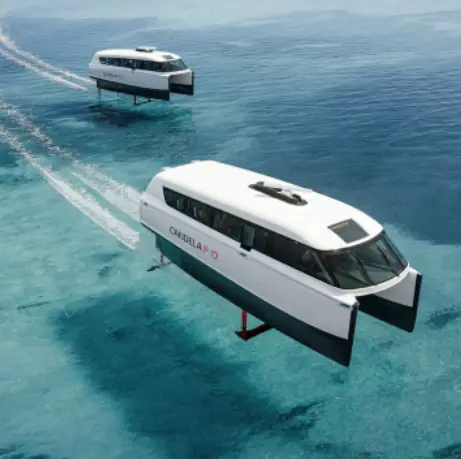In a landmark deal, the Candela P-12, the first electric hydrofoil ship, will service the planned water network in NEOM, the gigantic, sustainable development taking shape in Northwest Saudi Arabia.
NEOM has procured an initial batch of eight of the foiling, electric shuttle ships, making it the largest announced order in Candela’s history.
“The P-12 is designed to create zero-emission water transport systems which have significant improvements over traditional water commuting” says Gustav Hasselskog, CEO and Founder of Candela.
“Unlike legacy systems with large, slow, and energy-inefficient conventional ferries, the Candela P-12 is a smaller and faster unit, allowing much more frequent departures and quicker journeys for passengers. All daily necessities and services will be just a short boat commute away.”
Candela P-12 was launched last year and is set to debut in Stockholm’s public transport during fall 2024.
Flying above the waves on computer-guided underwater wings, hydrofoils, the P-12 uses 80% less energy than conventional ships, allowing it to combine long range and high speed for the first time in an electric vessel. With a speed of 25 knots and more than two hours of endurance, the Candela P-12 holds the distinction of being the fastest and longest-range electric passenger ship to date.
The hydrofoils also unlock a new level of comfort. Passengers will fly smoothly over the Red Sea, as the P-12’s digital flight control system balances the ship 100 times per second by adjusting the hydrofoils’ angle of attack, keeping it stable even in winds and waves.
As fuel usage rather than the manufacturing phase makes up the bulk of a ships’ environmental impact, energy efficiency is crucial to curb emissions. Since Candela’s foiling vessels use 80% less energy than conventional ships of the same size, a life cycle analysis performed by the KTH Royal Institute of Technology in Stockholm concluded that a P-12 will emit 97.5% less CO2 during its lifetime compared to a conventional diesel vessel of the same size.
The electric Candela C-POD motors, located in pods underwater, are exceptionally silent and create minimal disturbance for marine wildlife. When flying, the P-12 creates only a negligible wake, allowing for quicker journeys where conventional ships are speed-restricted due to their massive and damaging wakes.
“We’re extremely proud to provide a vessel system designed with both passengers and the environment in mind. Short waiting times, quick connections, and a very enjoyable experience without taxing the environment with wakes, emissions, and noise will revolutionize how we travel on water,” said Gustav Hasselskog of Candela.
The first batch of eight vessels will be delivered in 2025 and early 2026.
Original article source:
FAQ
- What is the Candela NEOM deal?
Candela has agreed to supply its flying electric ships to NEOM, a large-scale, futuristic city project in Saudi Arabia. These ships, known for their energy efficiency and minimal environmental impact, will be used for transportation within the NEOM development.
- What are Candela’s flying electric ships?
Candela’s flying electric ships are advanced watercraft that use hydrofoil technology to lift the hull above water, reducing drag and allowing for smoother, faster, and more energy-efficient travel. These ships are powered by electric motors, making them environmentally friendly with zero emissions.
- What is NEOM, and why is it significant?
NEOM is a planned $500 billion megacity in northwestern Saudi Arabia, envisioned as a hub for innovation, sustainability, and cutting-edge technology. The project is part of Saudi Arabia’s Vision 2030 initiative, which aims to diversify the country’s economy and reduce its dependence on oil.
- Why did NEOM choose Candela’s electric ships?
NEOM selected Candela’s electric ships because they align with the city’s sustainability goals. These ships offer a clean and energy-efficient mode of transportation, reducing the environmental impact compared to traditional fuel-powered boats. Their innovative design also complements NEOM’s futuristic vision.
- How do Candela’s flying electric ships work?
Candela’s ships are equipped with hydrofoils, which lift the vessel above the water as it gains speed, drastically reducing water resistance. This allows the ships to travel faster and use less energy compared to conventional boats. The electric propulsion system ensures quiet and emission-free operation.
- What are the environmental benefits of using Candela’s ships in NEOM?
The main environmental benefits include zero emissions, reduced energy consumption, and lower water disturbance due to the hydrofoil design. These ships help NEOM maintain its commitment to sustainability by minimizing the ecological footprint of its transportation network.
- How many ships will Candela supply to NEOM?
The exact number of ships to be supplied has not been disclosed, but it is expected that Candela will provide a fleet of their electric hydrofoil boats to support various transportation needs within NEOM, including passenger transport and possibly logistics.
